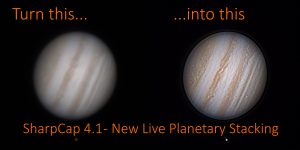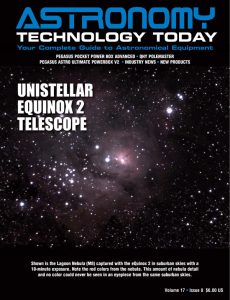As we noted earlier this year, SharpCap 4.1 has been released out of beta. One of the cool new features of the latest version release update is Planetary Live Stacking.
 SharpCap is an easy-to-use and powerful astronomy camera capture tool that can be used with dedicated astronomy cameras, solar cameras, webcams and USB frame grabbers. A wide range of features makes SharpCap suitable for many types of astro-imaging including Planetary, Lunar, Solar, Deep Sky and EAA (Electronically Assisted Astronomy).
SharpCap is an easy-to-use and powerful astronomy camera capture tool that can be used with dedicated astronomy cameras, solar cameras, webcams and USB frame grabbers. A wide range of features makes SharpCap suitable for many types of astro-imaging including Planetary, Lunar, Solar, Deep Sky and EAA (Electronically Assisted Astronomy).
As the publisher notes, “Planetary imaging has always been a two stage or even three stage process – first capture videos of thousands of frames, then process those videos through your favorite stacking program and then quite likely take the resulting image into yet another application for sharpening. This new update lets all of that happen live while you are observing. The latest SharpCap 4.1 update (version 4.1.11351.0) contains the first release of this live planetary stacking feature, which allows you to stack and wavelet sharpen your planetary images within SharpCap while imaging. While you will never get quite the same quality as using a separate stacking program after capturing, the results are impressive and will be great for outreach, live broadcasts, etc.”
You can learn more about using SharpCap for Planetary Live Stacking here.

 And to make it easier for you to get the most extensive news, articles and reviews that are only available in the magazine pages of Astronomy Technology Today, we are offering a 1-year magazine subscription for only $6! Or, for an even better deal, we are offering 2 years for only $9. Click here to get these deals which only will be available for a very limited time. You can also check out a free sample issue here.
And to make it easier for you to get the most extensive news, articles and reviews that are only available in the magazine pages of Astronomy Technology Today, we are offering a 1-year magazine subscription for only $6! Or, for an even better deal, we are offering 2 years for only $9. Click here to get these deals which only will be available for a very limited time. You can also check out a free sample issue here.
The Sun is more active than it’s been in years and if that’s not enough, we have the upcoming Total Solar Eclipse on April 8, 2024! If you’d like to learn more about the technology behind solar observing, solar imaging and more, you can check out our new monthly magazine – Solar Astronomy Today. It’s free to read, no subscription needed and available here. And if you are preparing for the upcoming eclipses and want to know your equipment options from solar glasses to the most out of this world solar viewing and imaging options, check out our free publication – The Definitive Guide to Viewing and Imaging the Sun – simply click here and enjoy reading!



